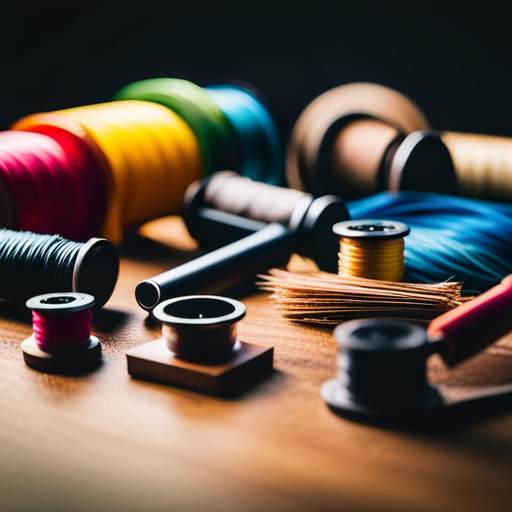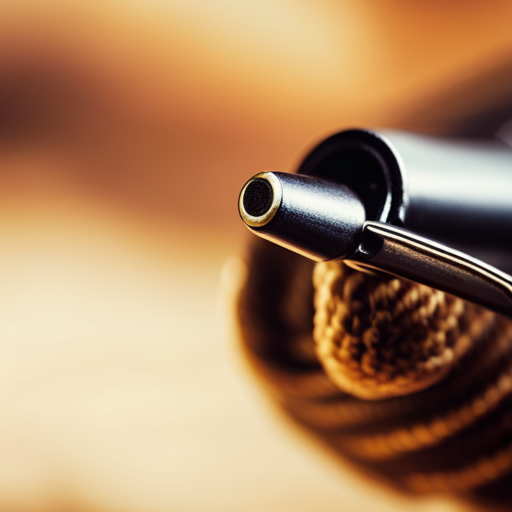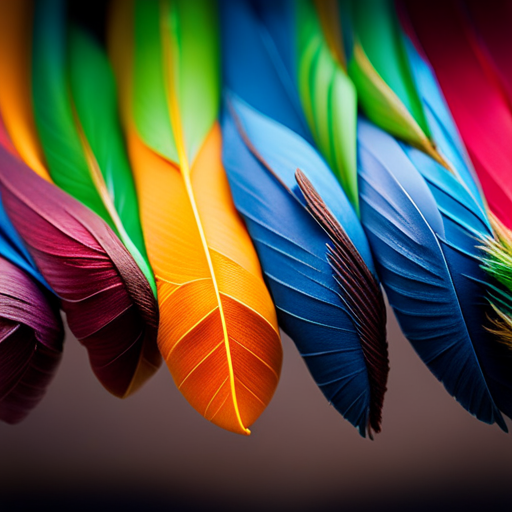Did you know that the right choice of fly tying ribbing can significantly increase the effectiveness of your flies? With countless options available, selecting the perfect ribbing can be a daunting task.
In this article, we will explore essential tips for choosing the right fly tying ribbing, including considerations such as purpose, materials, durability, and more.
By understanding these factors, you can enhance the appeal and performance of your flies for a successful fishing experience.
Consider Your Fly’s Purpose
When selecting ribbing for your fly tying, it is essential to consider your fly’s purpose and the specific qualities it requires. Different fly tying techniques and materials are used to achieve varying effects.
For instance, if you are tying a nymph fly pattern that needs to sink quickly, using a ribbing material with added weight like lead wire or tungsten beads can be advantageous. On the other hand, for dry flies where buoyancy is crucial, a lighter, more delicate ribbing material such as stripped quills or fine tinsel would be more appropriate.
Understanding the behavior and habitat of the target fish species is also crucial when considering your fly’s purpose. For example, if you are tying a fly to imitate a caddis larva found in fast-flowing streams, utilizing a ribbing material that can create a segmented effect to mimic the natural insect can greatly improve the effectiveness of the fly.
In essence, the purpose of the fly drives the choice of ribbing material and technique, and a solid understanding of the intended application is vital for successful fly tying.
Understand Different Ribbing Materials
When selecting ribbing materials for fly tying, it’s essential to consider the advantages and disadvantages of metal versus synthetic options, as well as the impact of size and thickness on the fly’s appearance and behavior.
Moreover, the color and texture of the ribbing material can significantly influence the fly’s overall aesthetic appeal and its ability to attract fish.
Understanding these different ribbing materials will enable fly tiers to make informed choices that suit their specific fly tying needs and fishing objectives.
Metal Vs. Synthetic Ribbing
The selection of ribbing material is a crucial aspect of fly tying, with metal and synthetic options offering distinct advantages and considerations for anglers. When choosing between metal and synthetic ribbing, anglers should weigh the pros and cons of each material along with differences in application and fishing techniques.
| Metal Ribbing | Synthetic Ribbing |
|---|---|
| Pros: Durable and adds weight for sinking flies. | Pros: Lightweight, flexible, and available in various colors. |
| Cons: Can rust and may require extra care. | Cons: Less weight and may not sink flies as effectively. |
| Suitable for: Nymphs, wet flies, and streamers. | Suitable for: Dry flies, emergers, and lightweight nymphs. |
Understanding the differences in application and fishing techniques for each type of ribbing material is crucial for successful fly tying.
Transitioning into the subsequent section about ‘size and thickness’, the dimensions of ribbing play a crucial role in determining the appearance and effectiveness of the fly pattern.
Size and Thickness
Transitioning from the contrasting qualities of metal and synthetic ribbing, it is essential to consider the impact of size and thickness on the overall effectiveness and appearance of the fly pattern. When selecting ribbing materials, anglers should pay close attention to the following factors:
-
Thickness Options
-
Thin ribbing materials create a more delicate and subtle appearance, ideal for imitating small insects.
-
Thicker ribbing adds durability and can create a more pronounced segmentation effect, suitable for larger flies or those intended for aggressive fish.
-
Medium thickness strikes a balance between the two, offering versatility for various fly patterns and sizes.
-
Size Variations
-
Different ribbing materials come in various sizes, allowing anglers to match the scale of the ribbing to the size of the fly being tied.
Color and Texture
In evaluating different ribbing materials for fly tying, it is crucial to consider the color and texture with which the materials enhance the appearance and effectiveness of the fly pattern. Color contrast can make the ribbing stand out, attracting the attention of fish, while a textured effect can add depth and realism to the fly. Additionally, the color and texture of the ribbing can be used for temperature control, influencing the way the fly behaves in the water. Seasonal variations play a significant role in the choice of color and texture, as certain colors and textures may be more effective at specific times of the year. Consider the following table for a quick reference guide:
| Ribbing Material | Color | Texture |
|---|---|---|
| Copper Wire | Red | Smooth |
| Tinsel | Gold | Ribbed |
| Thread | Black | Fuzzy |
| Mylar | Silver | Shiny |
| Lead Wire | Green | Wrinkled |
Evaluate Durability and Strength
When evaluating the durability and strength of fly tying ribbing, it is essential to consider the various material options available. Assessing the tension and flexibility of the ribbing is also crucial in determining its ability to withstand the rigors of fly fishing.
These factors play a significant role in ensuring that the chosen ribbing can endure the demands of tying and fishing flies effectively.
Consider Material Options
Selecting a suitable material for fly tying ribbing is essential to ensure durability and strength in the final fly pattern. When considering material options, it’s important to compare different materials and their application techniques.
Here are some factors to evaluate when choosing ribbing materials:
-
Wire: Strong and durable, wire ribbing is ideal for adding weight to the fly and creating a segmented body.
-
Tinsel: Offers a flashy, reflective quality, making it an excellent choice for adding a touch of sparkle to the fly pattern.
-
Synthetic Materials: Materials like Mylar or Flashabou provide durability and come in various colors for customization.
Understanding the strengths and weaknesses of each material will help in making an informed decision, ensuring the ribbing suits the specific needs of the fly pattern. Assessing tension and flexibility will further refine the selection process.
Assess Tension and Flexibility
Once the suitable material for fly tying ribbing has been selected, it is crucial to assess the tension and flexibility of the chosen material to ensure durability and strength in the final fly pattern. Tension control and flexibility are essential factors to consider when evaluating the ribbing material.
Tension control allows for the adjustment of the material’s tightness around the fly pattern, while flexibility ensures that the ribbing can withstand the rigors of fishing without breaking or losing its shape.
Material compatibility and application techniques also play a vital role in determining the overall durability and strength of the ribbing. It’s important to choose a material that complements the intended fly pattern and to apply it using techniques that maximize its strength and longevity.
Assess Visibility and Attraction
Visibility and attraction are crucial considerations when assessing the effectiveness of fly tying ribbing.
The visibility assessment involves evaluating how easily the ribbing can be seen underwater, which is essential for the angler to track the fly.
On the other hand, the attraction analysis focuses on the ribbing’s ability to attract fish by mimicking the natural movements of insects or baitfish.
When considering visibility and attraction, here are some important points to keep in mind:
-
Color Contrast: Opt for ribbing colors that contrast with the fly’s body to ensure visibility in different water conditions.
-
Reflectivity: Choose ribbing materials with reflective qualities to attract fish by simulating the flash of natural prey.
-
Natural Movement: Select ribbing that can create lifelike movements in the water, enhancing the fly’s attractiveness to fish.
Match Ribbing to Fly Size
In ensuring the appropriate match of ribbing to fly size, it is essential to consider the proportionality and balance of the ribbing in relation to the overall fly design, which directly impacts its effectiveness in attracting fish.
Fly tying techniques play a crucial role in this process, as the ribbing must complement the fly’s size and shape.
The fly fishing community emphasizes the significance of selecting the right ribbing to enhance the overall appeal of the fly to potential catches.
When choosing ribbing, it is crucial to take into account the hook size, as larger hooks may require stronger and more pronounced ribbing, while smaller hooks may benefit from finer ribbing for a more delicate appearance.
Additionally, the versatility of the fly pattern should be considered when matching ribbing to fly size. A versatile ribbing choice can allow for the adaptation of the fly to different fishing conditions and target species, providing an added dimension to the fly’s functionality.
Ultimately, a well-matched ribbing contributes to the overall balance and effectiveness of the fly, making it a critical aspect of successful fly tying.
Explore Color and Texture Options
When exploring color and texture options for fly tying ribbing, it is important to consider the visual appeal and tactile characteristics that will enhance the fly’s overall effectiveness.
-
Color Options
-
Natural Hues: Earthy tones such as brown, olive, and tan are versatile options that mimic natural insect colors, making them effective for imitating various aquatic insects.
-
Bright Colors: Vibrant shades like red, orange, and chartreuse can attract aggressive strikes, especially in murky waters or low light conditions, making them suitable for attracting fish’s attention.
-
Iridescent Finishes: Ribbing with iridescent or metallic finishes can add a reflective quality, mimicking the natural shimmer of insects and baitfish, thereby increasing the fly’s attractiveness.
-
Texture Variety
-
Smooth Ribbing: Provides a sleek and streamlined appearance, suitable for imitating slender-bodied insects or emergers.
-
Rough Textures: Mimic the coarse texture of larger insects or provide a more substantial profile, making them ideal for creating nymph patterns that need to stand out.
Exploring diverse color options and texture variety not only adds visual appeal but also enhances the fly’s effectiveness in imitating natural prey, ultimately increasing its success in enticing fish.
Factor in Water Conditions
Consider the water conditions when selecting the appropriate fly tying ribbing for your fishing needs. Factors such as water temperature and fly presentation play a crucial role in determining the most effective ribbing for your flies. Different water conditions require different approaches, and understanding how they impact fish behavior can significantly improve your chances of a successful catch.
| Water Conditions | Water Temperature | Fly Presentation |
|---|---|---|
| Cold Water | Low | Subtle |
| Warm Water | High | Aggressive |
| Clear Water | Varies | Realistic |
| Murky Water | Varies | Attention-Grabbing |
Water temperature directly affects fish metabolism and feeding patterns. In cold water, fish are less active and require a more subtle presentation, making thin and delicate ribbing a suitable choice. In contrast, warm water increases fish activity, necessitating a more aggressive fly presentation, which can be achieved with thicker and more prominent ribbing. Additionally, clear water demands a realistic fly presentation to avoid spooking the fish, while murky water requires attention-grabbing ribbing to enhance visibility and provoke strikes. By considering these water conditions, you can tailor your fly tying ribbing to maximize your angling success.
Experiment With Ribbing Techniques
Understanding different ribbing techniques is essential for tailoring your fly tying approach to the specific water conditions, ensuring a successful fly presentation for your fishing endeavors. Experimenting with ribbing techniques allows for innovative styles and creative applications, enhancing the effectiveness of your flies.
Here are a few ribbing techniques to consider:
-
Counter-Ribbing: This technique involves wrapping the ribbing material in the opposite direction of the body material. It adds durability to the fly and creates a ribbed effect that stands out.
-
Segmented Ribbing: By using different colors or materials for each segment, you can create a more lifelike appearance, imitating the natural segmentation found in insect bodies.
-
Wire Ribbing: Utilizing wire as a ribbing material not only adds weight to the fly but also provides a flash and creates a segmented effect, making it an excellent choice for imitating the look of emerging insects.
Experimenting with these techniques and integrating them into your fly tying repertoire can lead to the development of innovative styles that are tailored to specific fishing scenarios, ultimately increasing your chances of a successful catch.
Frequently Asked Questions
Can Ribbing Materials Be Used for Other Purposes Besides Fly Tying?
Ribbing alternatives can be creatively repurposed beyond fly tying. They offer benefits such as adding texture and strength to various crafts. However, limitations may arise due to specific material properties not suiting all applications.
What Are Some Common Mistakes to Avoid When Choosing Ribbing Materials?
When selecting ribbing materials, common mistakes can be avoided by prioritizing quality over quantity and assessing material suitability. Proper selection is crucial to ensure the ribbing enhances the fly tying process effectively.
Are There Any Environmental Considerations When Selecting Ribbing Materials?
When selecting ribbing materials for fly tying, it’s important to consider the environmental impact. Opting for sustainable options like biodegradable or recycled materials can help minimize the ecological footprint and support conservation efforts.
How Can Ribbing Techniques Affect the Overall Appearance and Performance of the Fly?
Ribbing techniques play a critical role in the visual impact, durability, and performance of fly patterns. Careful selection and application of ribbing materials can significantly enhance the overall appearance and effectiveness of the fly. Additionally, considering environmental impact is crucial.
Can Ribbing Be Added or Changed After the Fly Has Been Completed?
Adding ribbing after completion requires delicate handling and expertise in fly tying techniques. Changing ribbing materials may impact the fly’s appearance and performance. Common mistakes include disrupting the fly’s balance and environmental impact.
Conclusion
In conclusion, choosing the right fly tying ribbing is essential for creating effective and attractive flies.
Consider the purpose of your fly, evaluate different ribbing materials for durability and strength, assess visibility and attraction, match ribbing to fly size, explore color and texture options, factor in water conditions, and experiment with ribbing techniques.
Did you know that 70% of fly fishers consider ribbing material to be a crucial factor in fly effectiveness?




